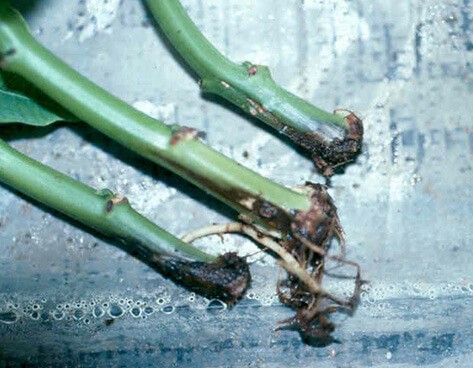Managing diseases in poinsettia production
Disease pressure varies by region in greenhouse poinsettia production, but the most common pathogens include Botrytis, Pythium and Rhizoctonia. Not as common, but also not to be overlooked, are Phytophthora, powdery mildew and scab. All of these pathogens can be introduced on contaminated cuttings during propagation, so scouting for diseases should be a top priority from the beginning of poinsettia production.
// Pathogens
Root rot caused by Pythium is the most common disease affecting poinsettia production. Phytophthora and Rhizoctonia can also rot the roots of poinsettias, and under favorable conditions, move upward to affect the stem and lower branches. Botrytis is the primary disease affecting poinsettia stems, leaves and bracts at all stages of production. Cuttings can be contaminated with Sphaceloma poinsettia, the cause of scab or spot anthracnose on both leaves and stems. Powdery mildew is most often a problem under cooler growing conditions.
// Symptoms
- Pythium is usually most serious in the early stages of poinsettia production when infected cuttings can wilt and die after transplanting. Plants that survive may be stunted, chlorotic, flower prematurely and drop leaves excessively.
- Botrytis can cause stem dieback and cankers, as well as blight on the leaves and bracts of poinsettias. Damaged tissues often appear wet and can be covered with gray spores (gray mold) of the fungus.
- Rhizoctonia is most damaging during propagation under warm to hot conditions ranging from 68-to-86°F. Rhizoctonia forms tan lesions with dark borders on the lower stem and the fungus often girdles and kills the cutting. On older plants, Rhizoctonia can move up into the canopy and rot leaves and branches. Poinsettias are most susceptible during rooting and just prior to plant maturity.
- Phytophthora causes root and stem rot primarily, but the pathogen can also cause crown rot and blight. Infections on crowns and stems appear as dark purple to black lesions that quickly enlarge. Lesions on the leaves and bracts appear papery and turn light brown to black.




